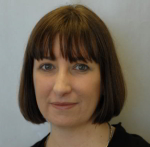This year’s CIEP conference was held online, from 12 to 14 September. Attendees from all over the world logged on to learn and socialise with their fellow editors and proofreaders, and a number of delegates kindly volunteered to write up the sessions for us. Kerrie-Anne Love reviewed Editors and copyright, presented by Pippa Smart.
 Could a monkey own copyright for a selfie?
Could a monkey own copyright for a selfie?
About a decade ago, an inquisitive macaque monkey named Naruto used a wildlife photographer’s camera to take a self-portrait. When David Slater claimed rights to the image after it was shared on social media, he was sued by animal rights group PETA which said Naruto was the owner. Slater eventually won copyright (and agreed to donate 25 per cent of the royalties to charity) but, as Pippa Smart explained in her conference session, ‘Editors and copyright: Myth-busting and good practice’, the case itself had wider ramifications.
Copyright, she observed, is a subject many people find intimidating or dull. ‘The problem is that copyright comes up when there’s a problem,’ she said, ‘so to many people copyright is a problematic issue, rather than an intellectually challenging issue that protects the rights of the creators.’ For editors, a good understanding is essential.
Starting with a quick-fire quiz, Pippa – who has worked in academic and research publishing for 30 years – proceeded to take us on a ‘whistle-stop’ tour of copyright law that was packed with thought-provoking case studies.
She explained that raw data isn’t protected and can be interpreted in artworks, animations, graphics, movies, and so on. Essentially, creativity is protected; for copyright to apply, the work has to involve some form of expression or intelligence. That’s where Naruto’s court case is relevant. The US court found that copyright can only be granted to something that has ‘intelligent intent’, so animals and machines don’t have rights. This has implications for the increasingly sophisticated area of works generated by artificial intelligence.
Pippa also touched upon social media and issues with image rights, permissions and the difficulties posed by so-called ‘orphan works’, where the copyright owner can’t be traced or identified. Likewise, there are pitfalls with open access licensing, more commonly found in academic publishing and publicly funded research, that allows reuse without permission. She emphasised the need for editors to always check because, for example, a work might be freely available but you may not be allowed to reuse it without seeking permission.
Another aspect to consider is that copyright is finite and usually lasts the lifetime of the author, plus an additional 70 years. But laws vary in different jurisdictions and are subject to change. While copyright may have expired in the country where a book or a creative work is being published, the publisher may need to seek permission in other territories.
In some countries, for example, France, an author’s moral rights may last forever, but there is no provision under US copyright law. Pippa advised that ‘no matter where you’re publishing, attribution and integrity should always be upheld’. It is good editing practice to ask for permission and check your facts and sources.
And finally, she made an interesting point that I had never really reflected upon. While copyright is protected by law, plagiarism is not illegal – although it may involve some degree of infringement and is widely seen as unacceptable!
The session covered a lot of ground in just an hour, and while the basics may seem relatively straightforward, as Pippa showed, there are plenty of grey areas. Just ask Naruto.
For guidance, see the Society of Authors website and its Guide to Copyright and Permissions.
 Kerrie-Anne Love copyedits fiction and memoir for independent authors.
Kerrie-Anne Love copyedits fiction and memoir for independent authors.
She has 30 years of publishing experience and is an Advanced Professional Member of the CIEP. Now based in Australia, she works with clients around the world.
 About the CIEP
About the CIEP
The Chartered Institute of Editing and Proofreading (CIEP) is a non-profit body promoting excellence in English language editing. We set and demonstrate editorial standards, and we are a community, training hub and support network for editorial professionals – the people who work to make text accurate, clear and fit for purpose.
Find out more about:
Posted by Abi Saffrey, CIEP blog coordinator.
The views expressed here do not necessarily reflect those of the CIEP.
